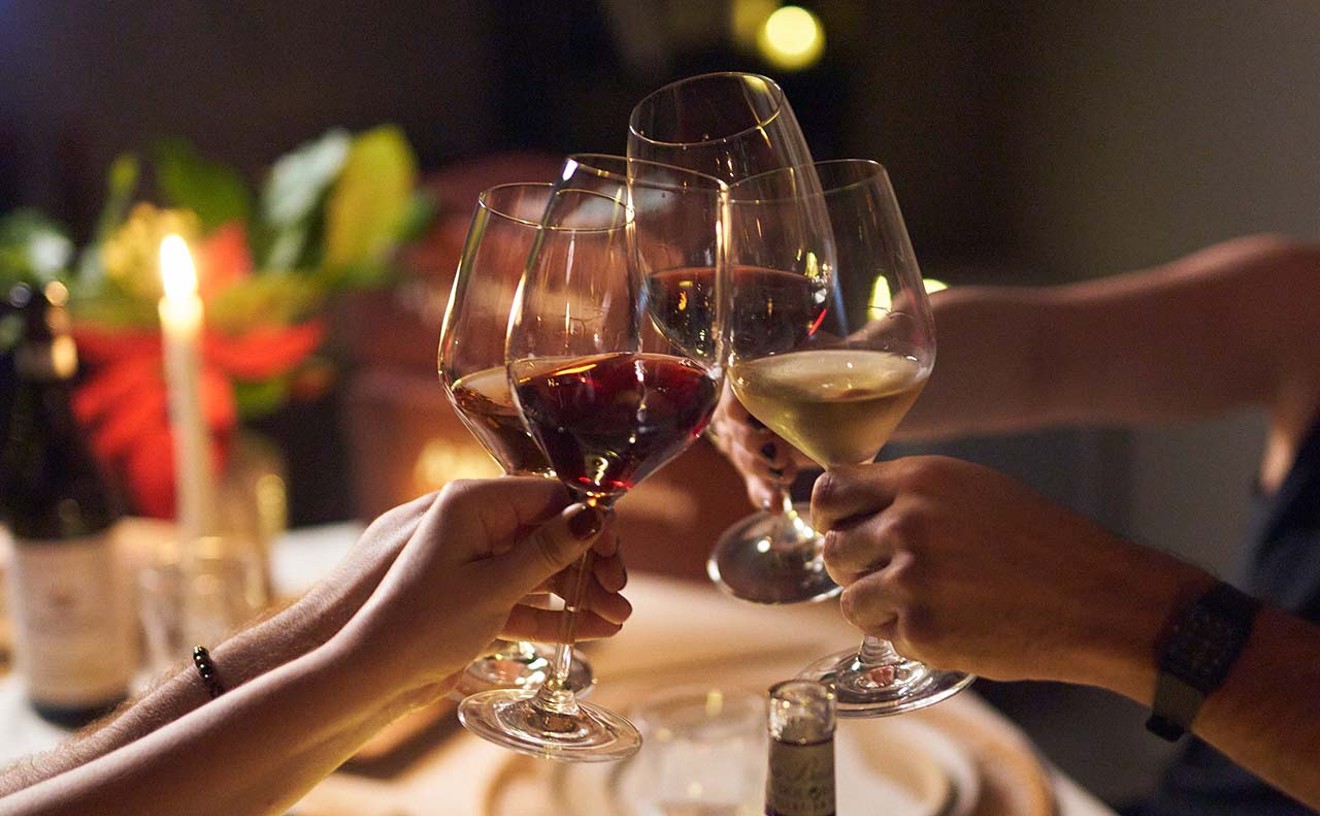At American fairs held in the early 20th Century, cigars would often be awarded to contestants who could ring a bell by hitting the base of a pole with a sledgehammer. It is believed the phrase "Close, but no cigar" came about as consolatory words for those who just missed the mark. Andalus, in Pacific Time's former Design District space, has been trying its best to resonate with diners since opening nearly three months ago. It is operated by the team behind Little Havana's El Rincón Asturiano, and its aim — an authentic Andalusian-style restaurant — is true. Nonetheless, a pair of dining experiences here didn't quite clang our chimes.
The dining room looks pretty much the same as it did when PT occupied it; a couple of black-and-white photos of Seville are the only regional additions. An open kitchen is visible on the left side; to the right is a bar backed by amber lighting. In between is empty space, because tables occupy only the rear half of the area. There weren't many patrons here during our visits, so the cool, capacious ambiance seemed all too quiet and cold — the antithesis of warm, boisterous tapas bars of Spain. On Thursdays and Fridays, though, we're told it lights up with flamenco music.
Tapas, too, stray from the norm — they are really full-size appetizer plates. There are 13 selections, mostly $10 to $15 apiece. If you visit Andalus alone or as a part of a couple, portion and price prohibit the sampling of more than a few items. That's not how tapas are supposed to work.
The so-called small plates comprise nine "calientes" and four "frias." Best sampled of the latter group was a plate loaded with moist, salty morsels of "cod carpaccio" ($15). The fish was hardly carpaccio-thin, but it was bacalao-delectable in a pool of fresh, grated tomatoes and a tributary of olive oil running through. Seafood salad was likewise flavorful — the medley of clams, shrimp, mussels, squid, and scallops marinated with peppers and onions in a zesty sherry vinaigrette.
Gambas al ajillo featured at least nine medium-size shrimp — not "prawns" — but no quibbling over the gutsy flavor ignited by slivers of garlic sautéed in olive oil. We also enjoyed the popular Andalusian snack chorizo a la sidra. The sausage, a mildly spiced variety here, is cooked with hard cider, garlic, smoky paprika, and olive oil and presented sliced and interspersed with dabs of soft goat cheese — all of which goes great with hunks of country bread.
An order of ajo blanco — a chilled white soup prepared by puréeing garlic, almonds, bread, and olive oil and served with a garnish of grapes — never arrived. The polite waitstaff performed decently enough, even if on one visit our water glasses remained unfilled and we waited too long for the check. But our server's lack of fluency in English was problematic and likely led to our missed soup — and perhaps other errors. For instance, we mistakenly forgot to indicate our preference for croquetas (the choice was ham, chicken, or cod). Instead of asking which one we wanted, the waiter brought a quintet filled with the fish. They proved to be excellent — creamy, delicately seasoned bacalao purée barely contained by a thin, crackly coat of lightly browned breading. A bold aioli on the side paired well with the assertive fish flavor.
When we told the waiter we would have preferred the ham, he brought us a couple to try; they were smoky-good.
Tablas, or wood boards garnished with charcuterie, are another alternative for starting your meal. The basic cheese board carries Manchego, Mahón, Tetilla, and Idiazábal. An assemblage of Serrano ham, chorizo, dry-cured pork loin, and salchichón, a dried white sausage, composes the Tabla de Ibéricos. Each is $15. Next step up is an $18 pâté selection of country, Provençal, and goose livers with raisins and wine. The prize platter presents the most delicate ham in the world, the chestnut-imbued pata negra from Jabugo, Spain ($35).
Nine seafood entrées are divvied into a trio apiece of sole, hake, and bacalao preparations. The sole comes à la meunière; simply grilled; and in Cava cream sauce. That last one sounded pretty tempting, but we placed our allegiance with the two signature seafoods of the region.
A square of firmly fleshed hake satisfied in a green sauce purée of parsley, white bread, garlic, olive oil, and wine. Adorning the fish were a couple of clams and shrimp, a limp spear of white asparagus, and half a hard-boiled egg with a gray-rimmed yolk. "Cod on the skin" came doused with a sleepy olive-oil-and-vinegar sauce kept awake only by a ringing kick of garlic. Both seafood courses were plated with blandly seasoned potatoes sautéed with onions (spuds with the cod also contained flecks of crisp Serrano ham).
The very reasonable price range of these imported fish dishes ($18 to $23) helps to mitigate some of the shortcomings. Seafood paella for two didn't carry that same compensation: It cost $40 yet brought mostly prosaic ingredients while lacking promised squid, fish, and peas. On the plus side were skin-on/head-on langoustines, mussels, and clams (as well as four barely noticeable, pencil-eraser-size nubs of bay scallops) embedded in impeccably firm grains of Calasparra rice. The flavor was a pleasant enough blend of saffron, fish stock, and sweet juices leaked from an overabundance of red and green peppers.
A better bet might be the meat paella, with chicken, pork, veal, chorizo, and chickpeas (also $40). Other nonseafood entrées are filet mignon, chicken breast, pork tenderloin, and veal and lamb chops cooked on the grill, along with a Serrano-and-cheese-stuffed chicken Cordon Bleu ($15 to $24).
Desserts include a thin, triangular wedge of marzipan cake that tasted fresh and homemade, but drizzles of chocolate and cherry syrups pretty much ruined it. We could have sworn our scoop of "nutmeg almond ice cream" was vanilla ice cream with chocolate syrup and crushed peanuts, but the waiter insisted the nuts were almond-and-honey "turrón." Was it rewarding nonetheless? Well, close, but...











